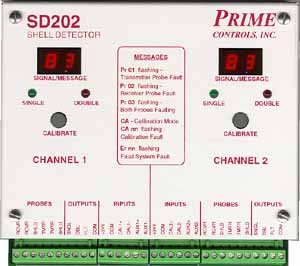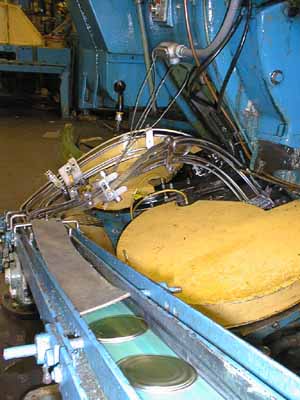 |
 |
|
 |
SD202
Dual Channel Double and Missing End Detector
""Great for Double end detection after end press and curler"
Prime’s versatile Model SD202 is fast enough to sense double ends in a conversion press or in the high velocity of a rotating curler. This dual channel, multifunctional detector is also used to monitor sheets entering a strip feed press and at the same time watch for single ends exiting after each stroke.
Any end or sheet between the probes for .003 seconds or longer is inspected. Beverage aluminum 202 ends traveling at 25 ft/second (150 ends/second) is inspected. Food 303 ends are detected even easier. |
The Model SD202 holds the output for a minimum of 25 milliseconds to allow a PLC time to recognize the double or to allow a latching relay to respond. The Model SD202 is two detectors in one package.
You can use the detector on two different lines or monitor two positions on the same line. It is easy to calibrate. Just press a push-button on the front of the detector, with a single end between the probes. It’s that easy. Two alphanumeric displays provide information on signal strength, calibration and detected faults. Pinpointing a system defect is easy with the Model SD202. |
|
| |
Features
- Push-button calibration optimizes settings and reduces time to set up.
- Microprocessor control provides better measuring resolution and reliability.
- Aluminum & Steel sensitivity eliminates the need to stock more than one model.
- Two detectors in one chassis provides a compact package and requires less panel space.
- Two digital displays to monitor relative thickness, signal strength and fault conditions.
- Diagnostic messages quickly isolate errors and failures in the detector and probes.
- Operating Power is standard 24 Volts DC.
- Six solid state transistor outputs for comprehensive control of Single. Double, No Tab, Tab & Channel Fault detection.
- Quick disconnect terminals decrease replacement downtime.
- Functionally compatible with early Prime & Hyde Park Models DS33, DS35, DS37,and DS38 and will fit in the same panel footprint.
- Optional communication port expands information to external systems.
|
Specifications:
- Power Input: (required), Voltage: 24 V DC *10 % ripple Current: >350 mA.
- Logic Inputs external designated Calibration and Auxiliary 1 & 2. Hardware consists of jumper selected transistor type : pull-up mode for source drivers, pull down for sinking drivers. (AUX. changes frequency to steel or aluminum optimum sensitivity)
- Logic Impedance is 4.7K ohms, response to less than 1 m Sec.
- Switching thresholds: above 6.4V when going high, below 5 volts when going low.
- Probe Inputs tuned for Prime transmitter and receivers only for each channel.
- Outputs (6) Transistor types, designated Single, Double, Tab, No-Tab, 2-Fault Jumper select current sinking or source Source current limit at 160 mA, combined outputs. Source voltage: 22 Volts Sinking current: 100 mA Max. Sinking voltage: 30 Volts Max.
- Probe Types AY, AV, AZA, CB, CFB and all in P15 family for optimal operation, also works with AK, AVB, CA, CF and P70 family but not optimized for best operation.*
- Response Time 1 to 16 m Sec (Effected by the metal type and the thickness during calibration).
- Thickness Range 1 mm (.040") with P15CS, Varies with probe and separation.
- Probe Separation max 75 mm with P15CS.
- Max range not advisable when trying to detect pull tab. For pull tab detection use any of the probe types recommended under Probe Types with 16 mm (.625") separation. Do not use probes ending with S.
- Reject threshold. Factory set to 50% ON and 30% OFF of calibrated nominal.
- Displays Two channel, two digit alphanumeric LED display. During operation indicates signal strength and fault location. During calibration nominal value or calibration fault.
- Indicator Lamps consist of two channels of green for present and red for over or under nominal value. Also flash for faults.
|
 |
Each channel has jumper changeable current sink or current source outputs for Double, Single and Fault warnings that can interface directly with most PLC-DC inputs. |
|
|
 |


